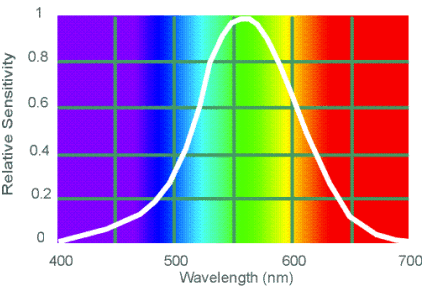The human eye is an incredibly complex detector of electromagnetic radiation with wavelengths between 380 to 770 nm. The sensitivity of the eye to light varies with wavelength (see the CIE photometric curve for the day vision – V(λ) – the photopic visual response function). Photometry can be considered radiometry weighted by the visual response of the “average” human eye: 1 Watt of radiant energy at λ = 555 nm (maximum sensitivity of the eye) equals 683 lumens. The eye has different responses as a function of wavelength when it is adapted to light conditions (photopic vision) and dark conditions (scotopic vision). Photometry is typically based on the eye’s photopic response [1].
Photometric theory does not address how we perceive colors. The light being measured can be monochromatic or a combination or continuum of wavelengths; the eye’s response is determined by the CIE weighting function. This underlines a crucial point: the only difference between radiometric and photometric theory is in their units of measurement.
Here are the photometric quantities and the relationship with their radiometric counterparts:
| (Radiometric) | Photometric | Symbol | Units |
| (Power) | Luminous Flux | λv | lumen (lm) |
| (Intensity) | Luminous Intensity | Iv | lm/sr = candela (cd) |
| (Irradiance) | Illuminance | Ev | lumen/m2 = lux |
| (Excitance) | Illuminance | Mv | lumen/m2 = lux |
| (Radiance) | Luminance | Lv | lm/(m2 sr) = cd/m2 = nit |
Photometry example: LED radiant intensity
A specification sheet says that a red LED, with a pick wavelength of λ = 630 nm, emits Iv = 20 mcd (millicandelas). We want to know how many Watts are incident on a photodetector used to measure the light produced by the LED (need to convert photometric specification to radiometric values). Solving this problem properly requires knowing the spectral distribution of LED radiant intensity that leads to Iv = 20 mcd:
![]()
where V(λ) is the photopic visual response function and Iλ(λ) is the radiant intensity distribution [2]. In practice determining the intensity is simplified by the existence of pre-calculated tables [3].

To find total emitted flux, multiply the result by the solid angle of LED emission.
References:
- Photometry (optics) on Wikipedia
- Luminosity function on Wikipedia
- Tables of luminosity functions on UCSD Color Vision

